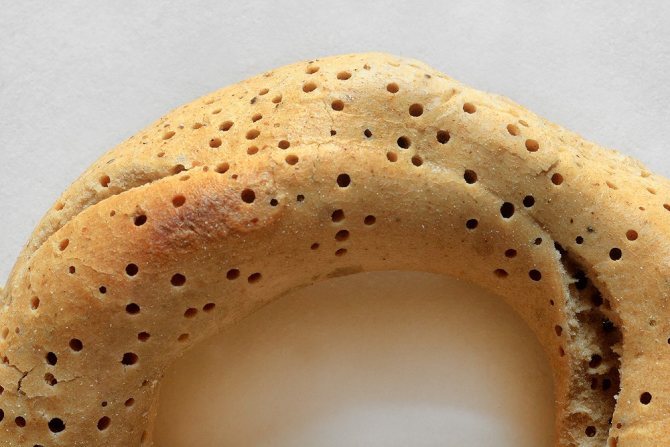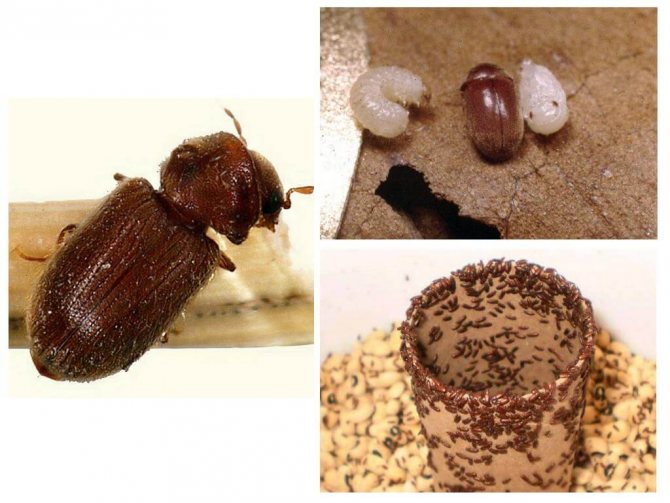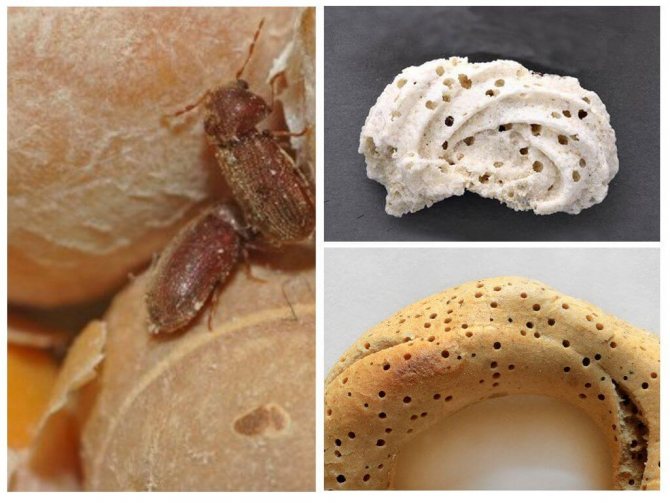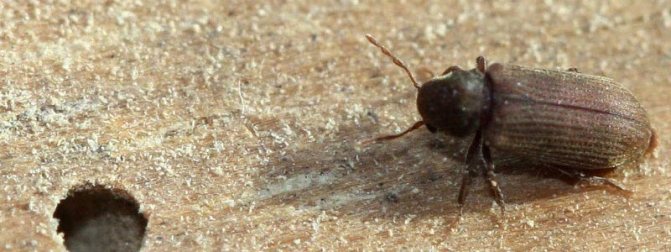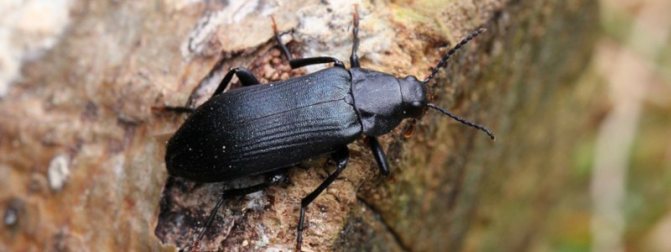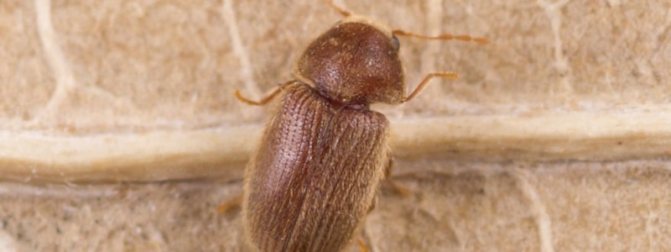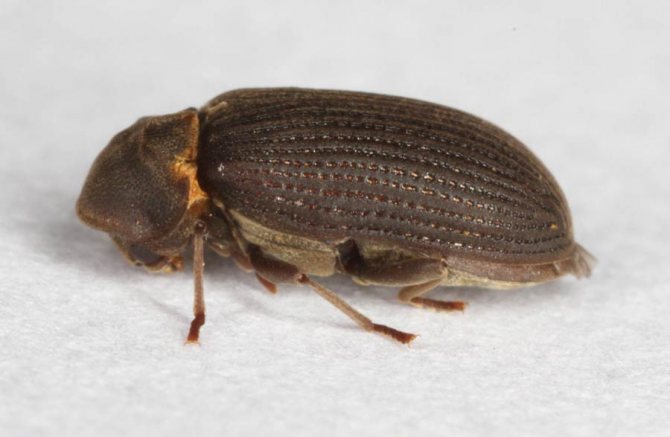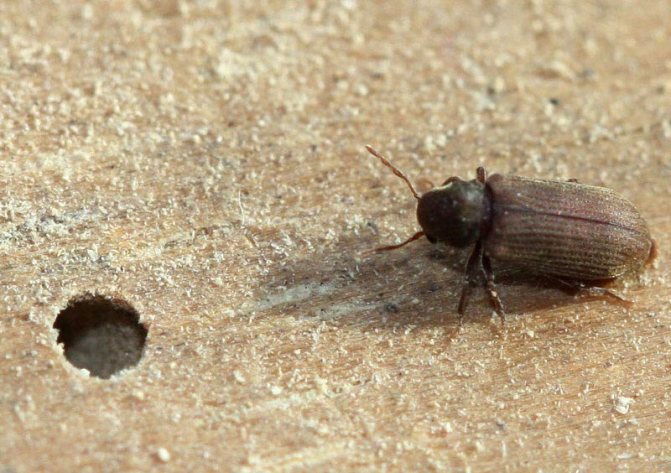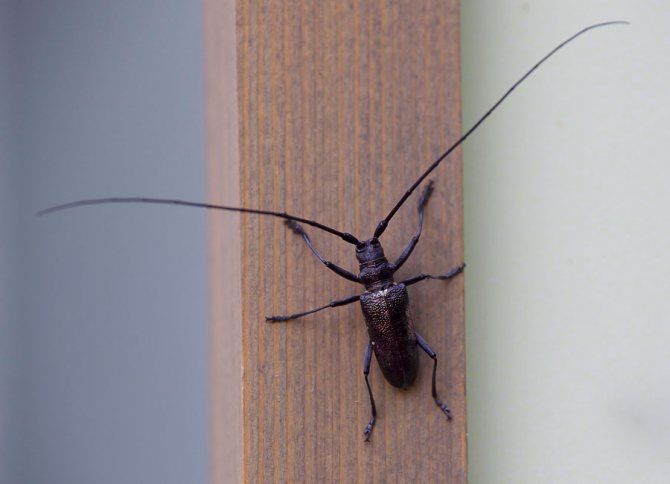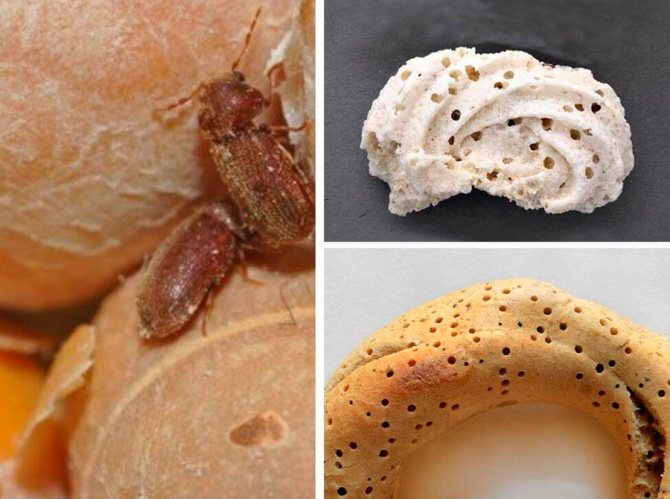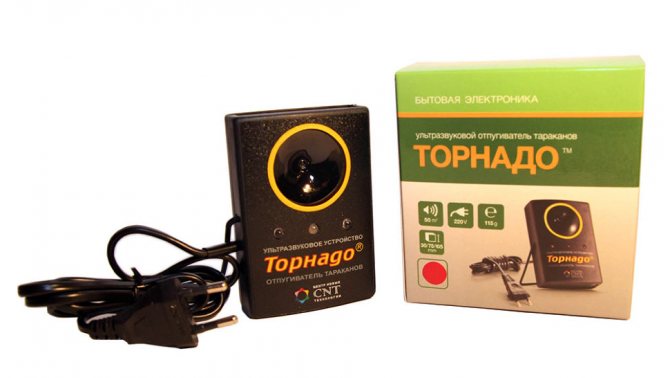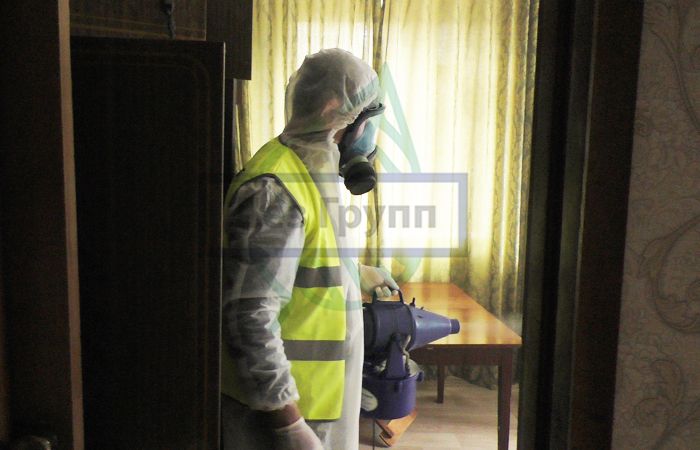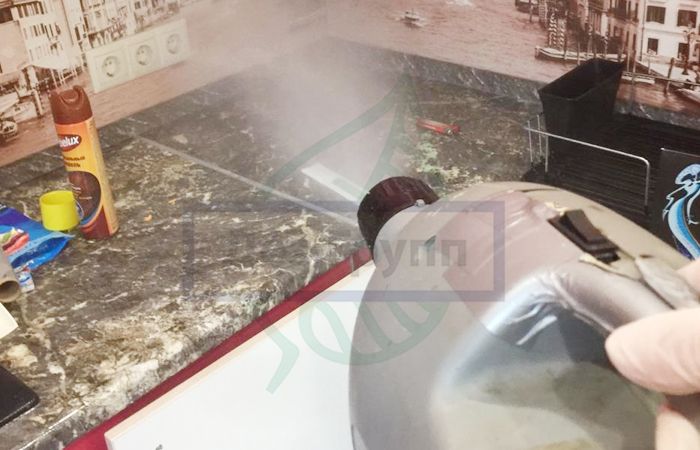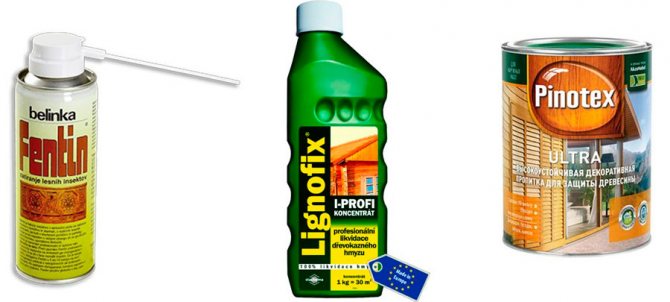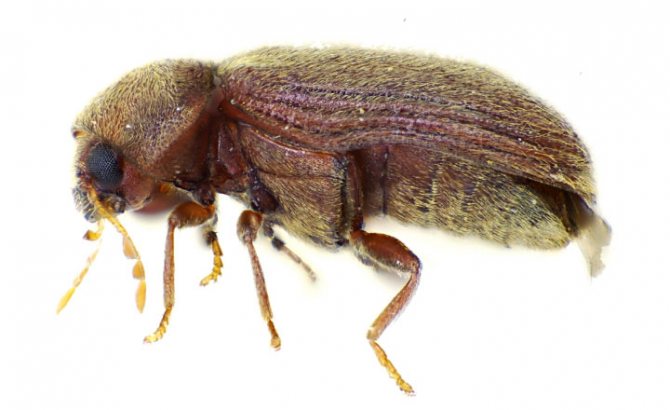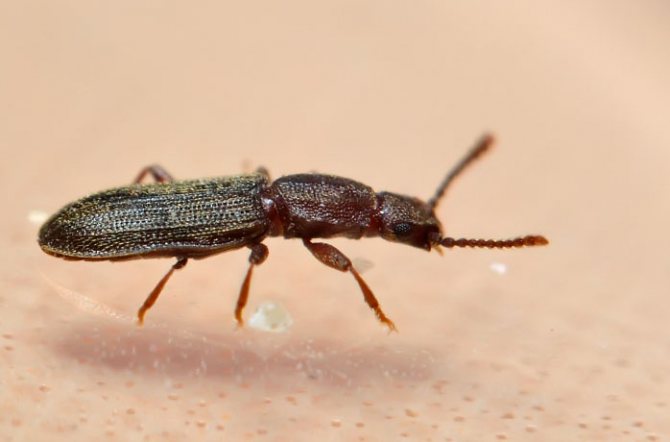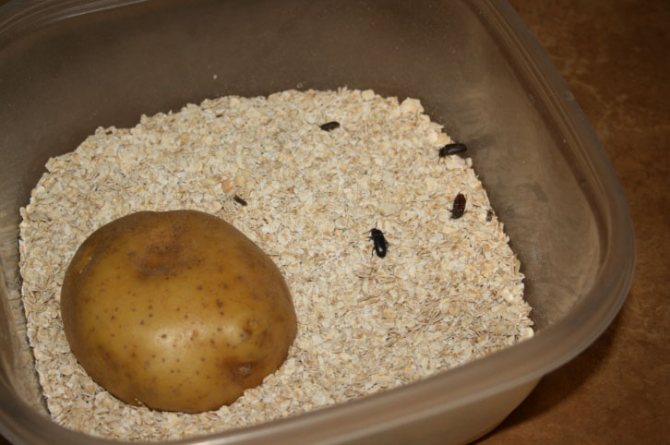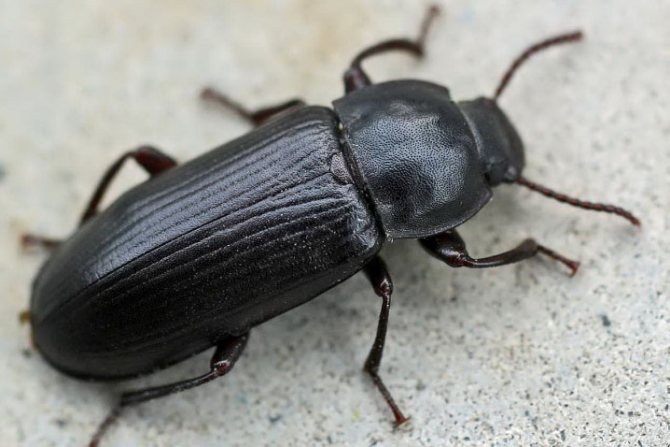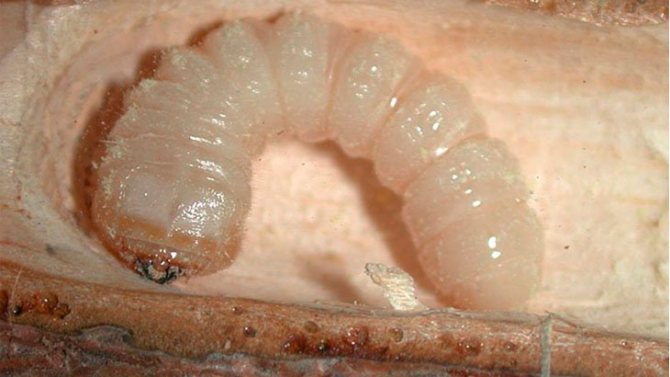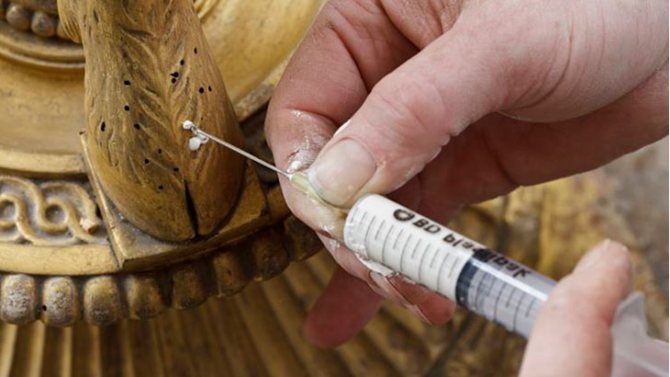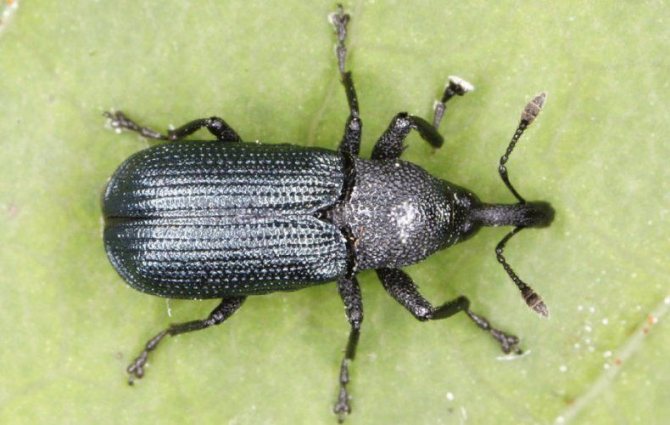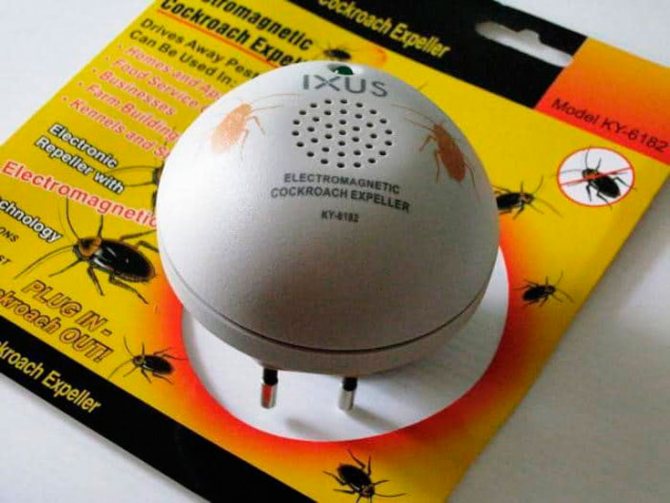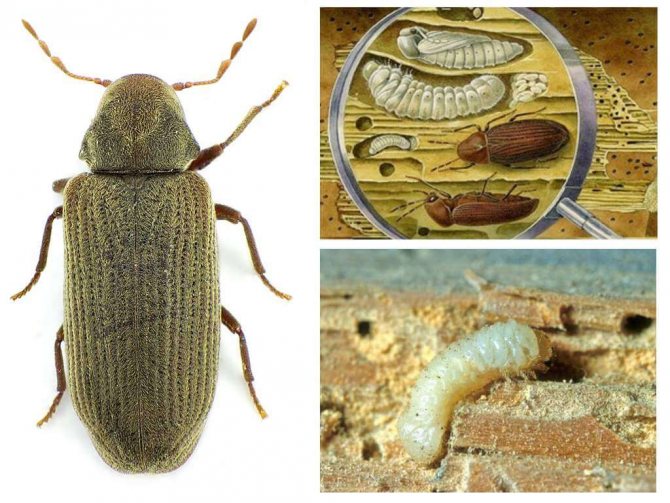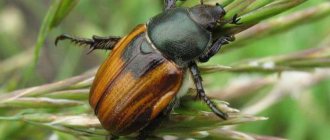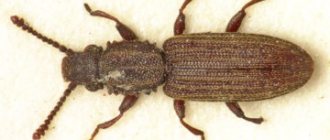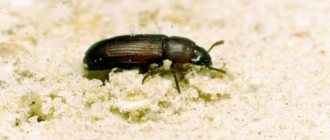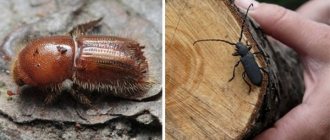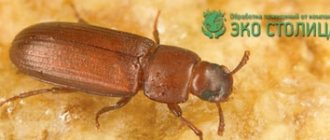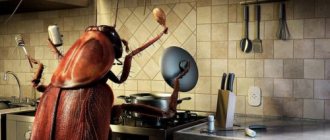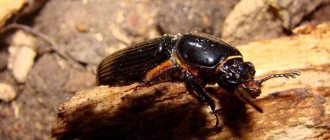Bread grinder - a nondescript bug that can inflict devastating damage to food supplies. The insect feeds on flour, cereals, breadcrumbs, cookies, animal feed, medicinal herbs, as well as books, herbaria, biological collections. With a small infection for a long time, the presence of a bread grinder remains unnoticed. When there are too many beetles, they begin to creep around the house in search of a new food base. Detailed instructions on recognizing insects and how to deal with them will help you quickly get rid of pests.
Who is he - a grain grinder?
The grain grinder is a small light brown (less often red-rusty) beetle, a resident of enclosed spaces, which is also a dangerous pest of food supplies. Moreover, damage is caused both by adult specimens that make holes in the food, and by the larvae.
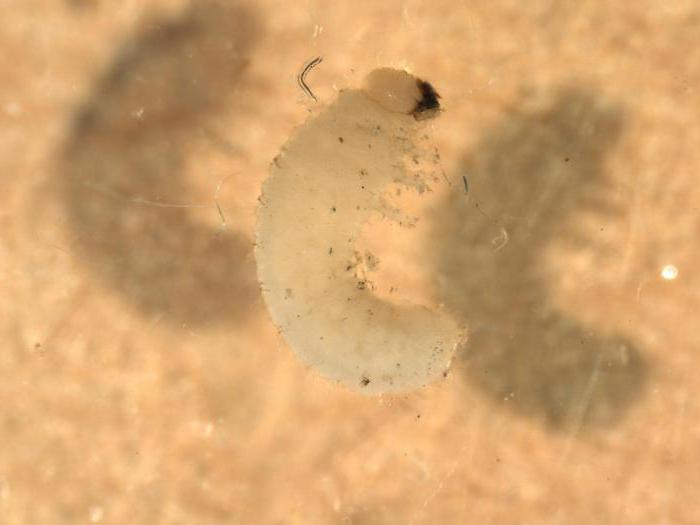
Indiscriminate in food, they eat or spoil everything that comes in their way. Grown-up individuals are especially unpleasant and dangerous. If adult pest beetles do not feed, but exist at the expense of fat reserves accumulated in the larval stage, then the "youth" easily penetrates food substrates, makes passages in them and fills them with waste.
Description of the pest of kitchen stocks
Drugstore beetle (from English - "pharmacy beetle") is characterized by small size (up to 4 mm) and an elongated convex body covered with soft hair. The small head of the coleoptera is immersed in a depression in the pronotum.
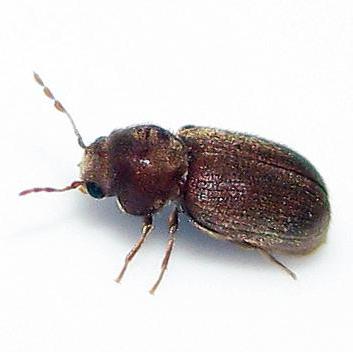

The chest is convex, deep grooves are clearly visible on the elytra. Antennae serrate, short, with three elongated and widened terminal segments. The full life cycle of a bread grinder lasts about 200 days, depending on the air temperature and the quality of the food. The bread grinder is resistant to low temperatures. At a temperature of + 4 ... + 5 ° C, the embryo in an egg is able to remain viable for about 4 months. Under natural conditions, a mass accumulation of beetles is observed in June-July, pest beetles live in the room constantly and can give one or two generations of young animals in a year.
Features of existence
The productivity of the female is from 20 to 60 oval milk-white eggs. The insect lays them in food, which will later become the object of food for newborns. Bread grinder larvae are characterized by off-white color, small size (about 5 mm in length) and short spines on the back. They are very similar to the larvae of the beetle, they have an arcuate curved fleshy body, well-developed upper jaws, covered with teeth.
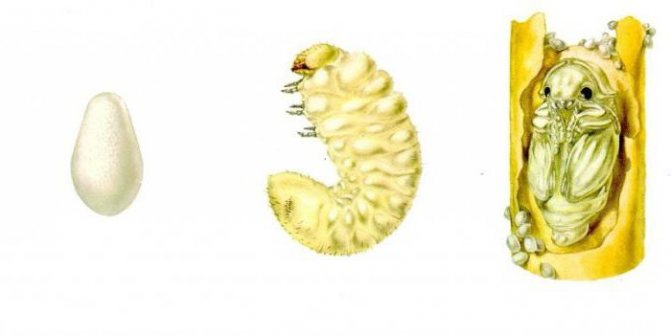

The general development cycle depends on the temperature regime: at + 17 ° C it is about 17 days; with an increase in the indicator by 10 ° C, it is halved. It prefers to pupate in kitchen supplies, constructing a cocoon of food microparticles around itself or gnawing cradle cereals in the grains. Pupa is yellow-white, 2.5-4 mm long.
Bugs in flour and cereals: what to do?
For a year, the grinder beetle is able to give one or two generations; in heated rooms, fertility is higher - up to five generations. The visual order in the lockers is not an indicator that they are free of pests.With a weak infection of products, the vital activity of insects usually proceeds imperceptibly, inside the food substrate.
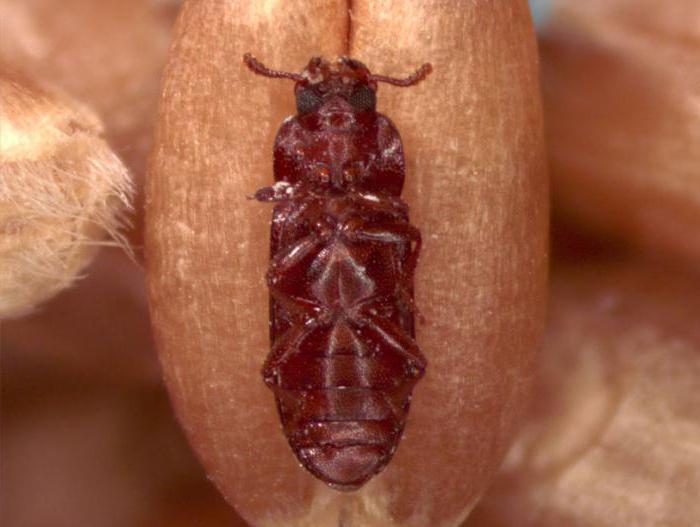

With a high population density, bugs in flour and cereals are forced to crawl out in search of new habitats, so they can be easily found on the surface of contaminated food. The bread grinder can get inside the room with purchases, in bags with cereals and flour, or through cracks in the frames and window vents. If there are bugs in the rump, what to do? How to get rid of uninvited pests once and for all?
The bread grinder flies perfectly; in the evening, like butterflies, gathers in flocks near a light source. In apartments, they can often be found on window sills.
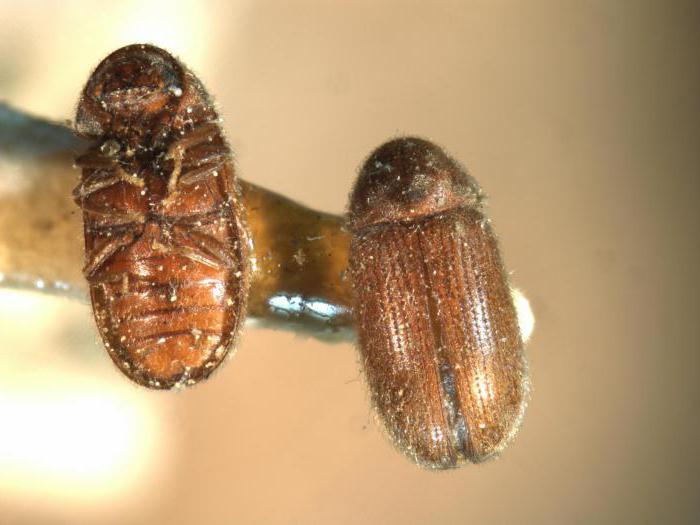

When touched, it freezes, pretending to be dead, or makes very unpleasant sounds.
Bugs started up in the kitchen: types of insects, causes of appearance, methods of struggle and prevention
- Control over the infestation of premises and equipment by insects and mites should be carried out regularly. [10]
- Local wet disinfection (wet disinfestation) of infected areas.
Physical and mechanical methods of pest control of grain stocks:
- Cooling of processed products, etc.
- Cleaning of processed products, etc.
Chemical methods of struggle
Preparations based on hydrogen phosphide (phosphine)
One of the important conditions for preventing the contamination of products, premises and equipment by pests at enterprises is good condition and cleanliness of warehouse and production facilities.
To prepare a delicious side dish or healthy porridge for your household, a good housewife in the kitchen always has a supply of cereals, which is stored in closed jars for bulk products in a dry place.
And where, then, do insects come from and how to get rid of bugs in the croup, if one day they appear there? In the kitchen, small black, brown, red beetles start very easily, or rather, we ourselves bring them into the house from the supermarket with flour, cereals, starch, pasta, dried fruits or beans.
The reason for the appearance of small pests in food lies in:
- in the initially poor special processing of grain in production, which should prevent the possibility of the development of living organisms in cereals and the laying of larvae;
- irresponsible checking by services at enterprises of the storage and packaging conditions of cereals;
- unscrupulous work of regulatory authorities monitoring the quality and service life of products, which should identify contaminated goods and rejected products should not be allowed for sale.
Most often, flour beetles, food moths start, multiply and live in the kitchen, less often grain grinders and red flour eaters. Grinders and flour eaters predominantly live in factories.
Indian moth
The food Indian moth is a small (8‒10 mm), gray-brown, striped and speckled butterfly, which is the main pest in the kitchen. High humidity and poor ventilation is an ideal environment for the existence and reproduction of moths.
Most often, this midge starts up in various cereals, flour, pasta, baby food, dried fruits, nuts, seeds, coffee. Insect larvae enter the house with food purchased in the store.
The butterfly is very hardy, resistant to low and high temperatures.
During the development and transformation of moths, many dead larvae, skins, feces remain in flour and cereals, so the use of such products in cooking is impossible.
Flour beetles are small (3 мм4 mm) brownish-brown beetles with short antennae, rounded barrels and small wings. Spreading throughout the kitchen from infected cereals, the insects crawl into the cracks of kitchen cabinets, an unsealed container with bulk products.
Khrushchaks' favorite food is flour, semolina, buckwheat, rice, millet, wheat groats, dried fruits. These insects reproduce very quickly under favorable conditions. Females can produce up to four generations per year. Foods damaged by the beetle are taken in lumps and become unusable.
Eating pests with food can cause allergies, digestive disorders and even poisoning.
Mucoedy
Ginger mucoids are small (1.5‒2.5 mm) oblong coleoptera, reddish in color, covered with silky villi with long antennae widely spaced. The habitat of bugs is granaries, mills, feed mills, bakeries.
The mucoids are bred in products with a moisture content of more than 15%, they prefer musty flour or cereals and dry animal feed. Bored and multiplying, bugs contaminate products with shells from larvae and excrement, increasing their moisture content. A distinctive feature of the presence of a flour eater at home is a sharpened wooden sieve.
Malicious activity of the grinder beetle
A bread grinder can spoil almost all products: flour, bread, cereals, crackers, tea, pasta. He does not disdain herbariums and dried herbs, even poisonous ones: belladonna, strychnine, ergot, aconite. A careful search for a grinder beetle can be found on bookshelves, where the larvae zealously destroy the paper, turning it into fine dusty dust. In the library environment, for such sabotage, the insect is called "book beetle". A kitchen dweller can even climb into cigarettes. The insect is not interested in wood, so you should not worry about wooden floors, walls and furniture.
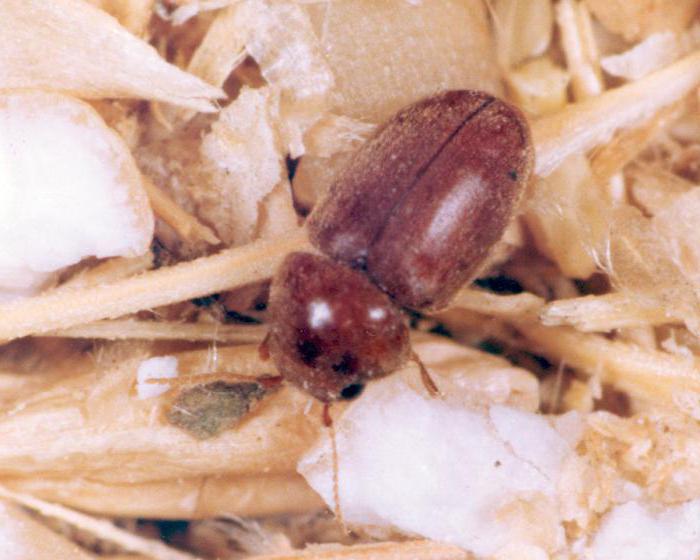

How to get rid of grinder bugs? Unlike a fast cockroach, rushing about the kitchen in search of food, the bread grinder is a constant insect. Having found a suitable product, the beetle firmly settles in it and begins to actively reproduce. You can identify the pest by the spoiled type of perforated products, the presence of dust and excrement in them. Grinder larvae are clearly visible in the breeding center.
The use of folk and chemicals
There are several popular ways to get rid of a bread grinder in the kitchen. They are quite effective, and, unlike chemicals, they are absolutely safe for the health of people and animals:
- Using pyrethrum powder, which can be purchased over the counter. It must be dissolved in a small amount of water and the resulting solution should be wiped every week in the kitchen cabinets until the insects disappear completely.
- Borax is often used to combat many types of pests. To use it to get rid of the bread grinder in the apartment, balls should be made. To do this, you need to mix borax with pre-crushed millet and powdered sugar. The prepared balls are laid out in the corners of the kitchen furniture.
- Borax combined with yeast. This is a very simple, but quite effective method of dealing with a grinder. Borax, yeast and sugar should be finely grated and, sprinkled on cardboard, spread out in places where insects are found.


The use of chemicals in the fight against this insect is highly undesirable. The main reason is that these beetles live mainly in food - after the use of poisonous substances, they can no longer be used for food.
If you spray the cabinet with the packages tightly closed, there will be no effect, since the chemical will not be able to penetrate the inside of the box or bag. In addition, any chemical preparation negatively affects the person carrying out the treatment.
The use of chemicals is justified only when the question arises of how to get rid of the grain grinder beetle in the books.If pests have occupied a bookshelf, then they can be dealt with by chemical treatment of shelves and cabinets.
If the books are severely damaged, they must be disposed of. In addition to using "chemistry", the book can be saved by leaving it for a day in the cold (at a temperature not exceeding -15 ° C).
Bread grinder: how to get rid of?
Pest control in the kitchen consists in the disposal of spoiled stocks and mechanical action on insects: catching and destruction. It is pointless to use insecticide treatment, since the poisons will definitely get on the products. And their use, even after heat treatment, is very dangerous to health. Therefore, heavily contaminated cereals, flour, tea and other damaged products should be thrown away, the shelves of the cabinets should be thoroughly wiped with vinegar, soda and bleach.
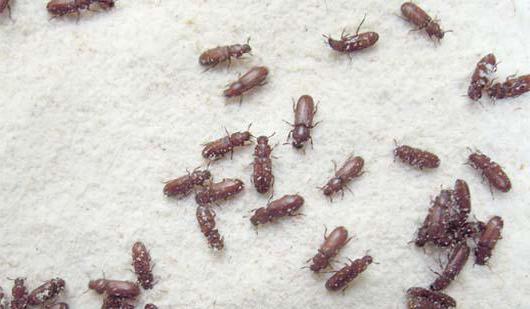

If bugs were found in jars, then glass containers must be soaked in water with a good portion of soap, left for a while, then thoroughly rinsed and dried. It is recommended to seal openings in wooden elements where pests can move. With a high number of beetles, sodium tetrabonate (borax), sold in any pharmacy, can be scattered on the shelves of the cabinets.
With a low degree of infection, cereals can be sieved and heated in the oven at a temperature of + 70 ° C for an hour. Or keep the food in the refrigerator for a day, then fry in a pan for 10-15 minutes. Infected peas or beans are recommended to be poured with hot water: beetles and larvae will float to the surface. Then the dried and sorted products must be dried on a clean cotton cloth.
How to deal with a beetle with insecticides - proven remedies
If the woodworm in the house "hunts" for a long time and successfully, folk remedies are unlikely to give the expected effect. The solution to the problem at the right level will be proven insecticides. Among them are preparations in the form of liquid, powder and gel. The latter are not so effective, but the liquid-form products really give the desired result due to the ability to penetrate deep into the surface of the tree to etch the pests out.
When choosing insecticidal preparations as a control measure, you need to know about some of the features of their use.
First, it is most convenient to apply liquid products to wood with a spray bottle. This is necessary in order for the preparation to penetrate into every even the most inconspicuous gap on the surface of the wood. Due to the effect of full penetration, some of the insects will die immediately, and the rest will be forced to leave the shelter.
Secondly, you need to remember about the dangers of insecticides in most cases for people and pets. This means that if beetles eat a tree at home, then surface treatment should be carried out only after all households and pets have been removed from the house for the duration of the drug.
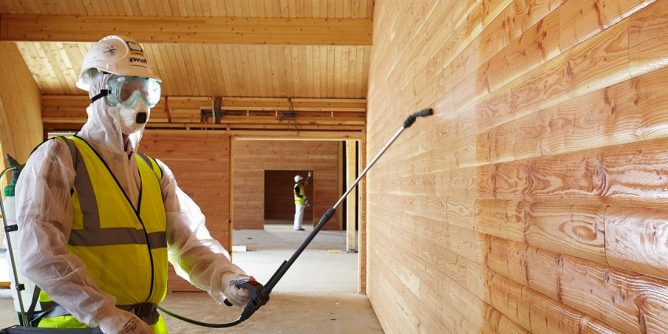

Thirdly, in order to achieve the desired result, the processing must be thorough. In hard-to-reach places where it is difficult to penetrate without external intervention, it is permissible to drill small holes, which, after the extermination of insects, can be simply repaired with wax or special glue for wood with shavings.
Known remedies against which the furniture beetle will not resist in most cases, even if the infection has acquired a large-scale character, are:
- Empire-20;
- "Antizhuk";
- "Woody Healer";
- "Belinka Belotsid".
Each of these agents acts for a long time, is actively absorbed into the surface of the tree, literally destroying beetles and preventing their appearance in the future. It is important to carefully read the instructions before using the drug. Only the drug is considered useful if the package contains a note on the possibility of using it against flying insects. Only such agents can be used against adults and their larvae.
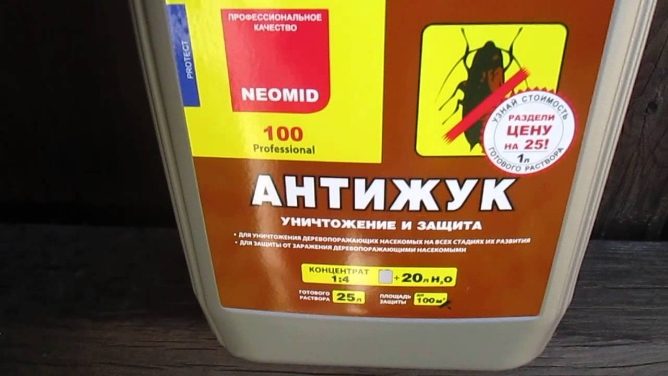

Do antiseptics work? If insects eat a tree at home or in storage areas, then antiseptics, subject to the right choice, can really act not only as a means for prevention, but also as an active drug. For example, the Mark 4 remedy has an effect at the initial stage of damage to a tree. The solution is injected into the holes left by the pest using a miniature oiler or syringe.
If the pest has managed to breed and the surface is damaged more seriously, in addition to douching, the surface is treated completely for reliability, capturing the edges by 500-700 mm. The tree is treated several times every 2-3 days until only traces of its violent activity remain on the surface of the pest.
Folk methods
To prevent the spread of the bread grinder in the kitchen, it is required to maintain perfect cleanliness, inspect the purchased cereals and flour for the presence of a bug. Use glass sealed containers for storage.
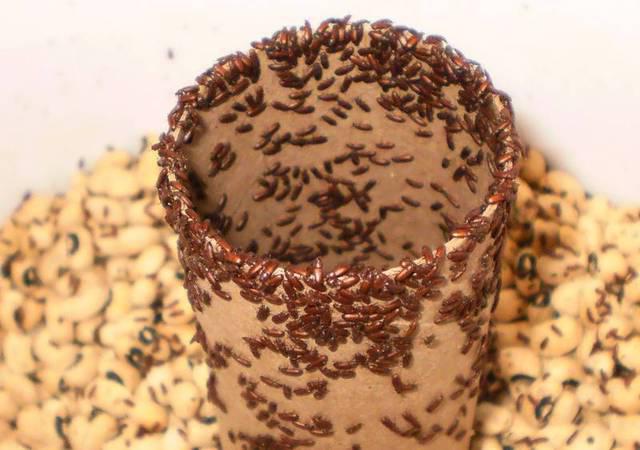

Products in paper, plastic or cloth bags are more susceptible to infection with a bread grinder, since it will not be difficult for an insect to gnaw through such material. As a protective measure, it is recommended to treat the cloth bag with a concentrated saline solution.
You can scare off the pest with ordinary garlic, several unpeeled cloves of which are recommended to be put in flour. In containers with cereals, it is advisable to place gauze bags filled with salt or bay leaves, the smell of which insects simply cannot stand. Periodically wipe down the shelves with vinegar and water. Store dried fruits, breads and nuts in the refrigerator. You should not buy cereals for future use, creating significant reserves - an excellent environment for the life of the larvae of the grain grinder.
Fighting the grinder outside the kitchen
Outside the kitchen, more effective measures can be used against the grinder: for cabinets with spoiled books - aerosol treatment with insecticides. Sprays such as Raptor, Reid, Combat will show a high result. To prevent the beetle from entering your territory, it is recommended to arrange bags of lavender and nutmeg on the shelves of cabinets, in herbariums and collections. The smells of such insect agents are deterrent.
The appearance of harmful beetles in the kitchen, and especially in food supplies, is unpleasant for any housewife, especially if the room is kept in order and cleanliness. You can get rid of the bread grinder only by cleaning, heating and freezing cereals. It is extremely dangerous to use insecticides, as it poses a direct threat to the residents of the house.
Prevention measures
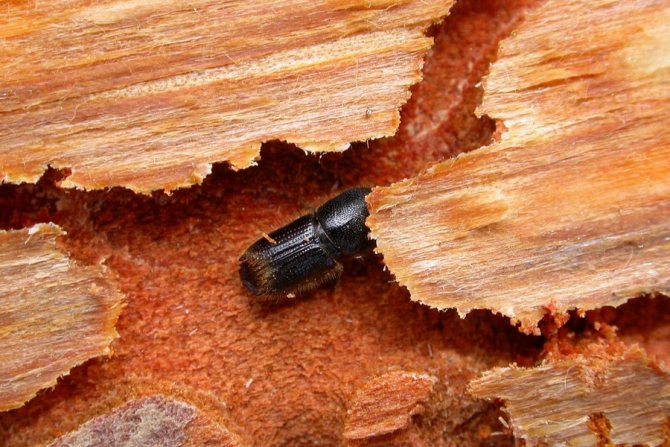

Protecting building structures from woodworm beetles is an important measure that will allow these structures to be operated for a long time, without the fear that they will become unusable. Before you carry out the processing of wood, you should do some activities. For example:
- Carry out a thorough examination of the building material, which will determine the presence of a grinder beetle in it.
- The bark must be removed from the wood and burned.
- For processing, special antiseptics of complex action are used.
- It is necessary to think about how to protect the future structure additionally: it may simply have to be plastered.
- Rooms with high humidity must be dried regularly using all available means.
- The furniture must be looked after using special means.
Thorough examination of wood building materials and their subsequent treatment with antiseptics is a guarantee of a long service life of wood structures. The service life can be increased if such structures are regularly maintained.

